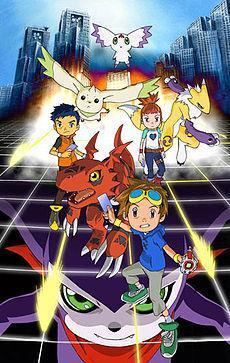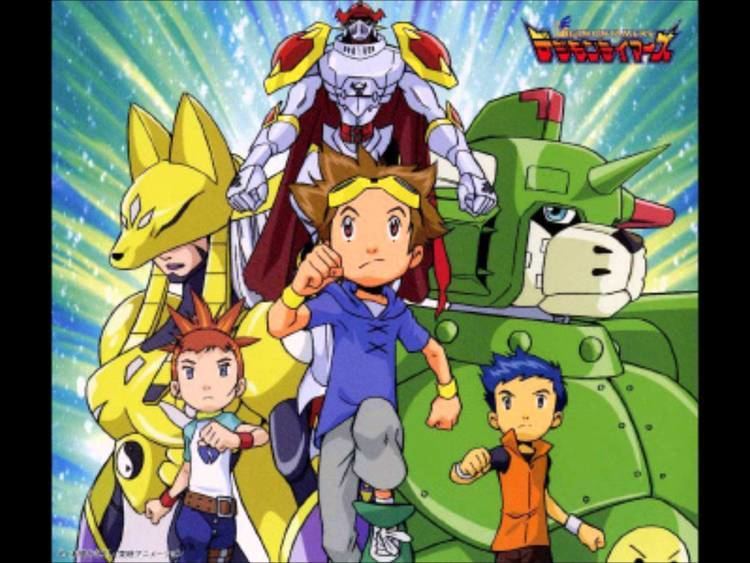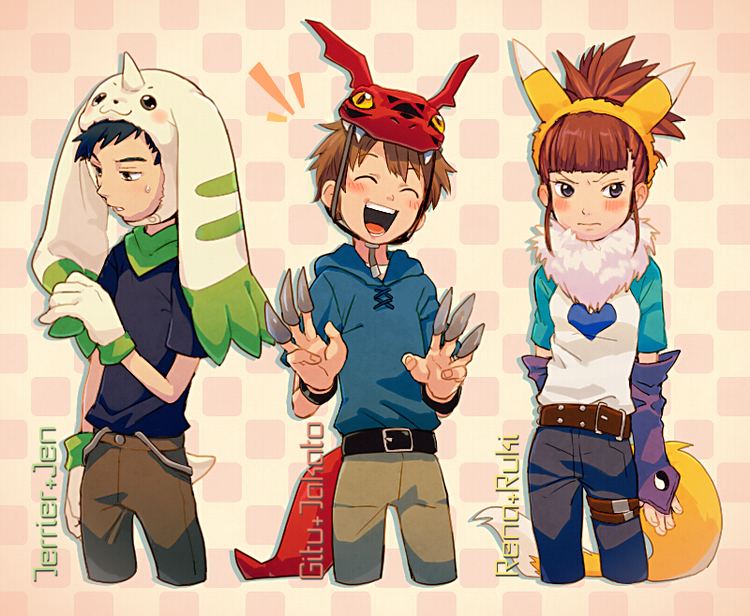Digimon Tamers
6 /10 1 Votes
Director Yukio Kaizawa | Genre Action-adventureScience fiction Duration | |||||||||||||||||||||||||||||||||
 | ||||||||||||||||||||||||||||||||||
Release date March 2, 2002 | ||||||||||||||||||||||||||||||||||
digimon digimon tamers cosplay pv tamers all ultimate evolution digimons ver
Digimon Tamers (デジモンテイマーズ, Dejimon Teimāzu), known outside Japan as season three of Digimon: Digital Monsters, is the third anime television series produced by Toei Animation based on the Japanese Digimon franchise. Unlike the previous seasons, Digimon Adventure and Digimon Adventure 02, Tamers takes place in a different universe, where the first two seasons are a TV show. The show mostly takes place in the real world and revolves heavily around the collectible card game based on the series.
Contents
- digimon digimon tamers cosplay pv tamers all ultimate evolution digimons ver
- eclipse trailer digimon tamers teaser trailer
- Plot
- Production
- Secondary characters
- Antagonists
- Anime television series
- Theme songs
- Digimon Tamers 1984
- Audio drama
- Reception
- References
This series is also known for its darker undertones and story plots, taking darker routes than in previous series. The anime has become controversial over the decade, with debates about how appropriate this show actually is for its "target" audience, especially due to Lovecraftian nature of the last arc. The English dub is more lighthearted dialogue-wise, though still not as much as previous series. Tamers aired in Japan between April 1, 2001 and March 31, 2002, whilst an English-language version by Saban Entertainment aired in North America between September 1, 2001 to June 8, 2002. A manga adaptation by Yuen Wong Yu ran between April and October 2004. It was succeeded by Digimon Frontier.

eclipse trailer digimon tamers teaser trailer
Plot

One day Takato creates his own Digimon Guilmon when he slips a mysterious blue card he found in his deck through his hand-held card reading device, changing it into a D-Power (called a D-Arc in Japan), the Tamers' version of a Digivice. The appearance and powers of his Digimon come from Takato's sketches that were scanned into the device. Guilmon bio-emerges from the Digital World and is found by Takato. In his attempts to hide his new friend, Takato meets other Tamers Henry who met Terriermon in a computer game, and Rika whose success in card game tournaments caused many Digimon to come to her when she received her D-Power, and she chose Renamon, promising to make her stronger. Early in the series, the three Tamers and their Digimon duel foreign Digimon emerging into their world. Takato, Henry and their partners quickly become friends and allies, while Rika and Renamon prefer to fight on their own; however, they all soon realise that much more is at stake and the six unite. During their escapades, they encounter the michevious and mysterious Calumon, who has the power to make other Digimon digivolve, but dislikes fighting, and Impmon, a cruel Digimon that left his twin Tamers because he was sick of their bickering and selfishness, and thinks that all Digimon with Tamers are a disgrace. Along the way, the kids learn to be responsible for those creatures as a mysterious man known as Yamaki tries to stop wild Digimon from coming to the real world. From the secret government agency called Hypnos, Yamaki is in charge of monitoring and covering up Digimon activity around the globe.

When Yamaki attempts to use his project, the Juggernaut program, to suck every Digimon back to the Digital World, a group of powerful Digimon calling themselves the Devas, who serve the Digimon Sovereigns, hijack the program and begin to enter the Real World. The Devas believe that true Digimon should not pair up with humans, and they fight the trio of Tamers and their Digimon to defend their world against them. The Devas' true purpose for entering the human world is eventually revealed; they wish to capture Calumon, and take him back to the Digital World, so that they can use his power of Digivolution. The Devas eventually succeed, although many are destroyed in the attempt. Impmon, meanwhile, is badly beaten by one of the Devas and is drawn back into the Digital World with the promise of power.

The Tamers then decide to rescue Calumon, and are surprised to find a portal to the Digital World under Guilmon's hiding place in a park. Several accompany them in their quest: Kazu and Kenta, Takato's trading card rivals, set out to find themselves a partner Digimon, while another friend Jeri, who met her partner Leomon in the Real World, sets out to prove her strength. Henry's little sister Suzie is later sent to the Digital World on her own. On their travels in the Digital World they meet Ryo (Rika's rival and legendary Digimon Tamer) and his savage partner Cyberdramon.

The Tamers destroy all but one of the remaining Devas (Antylamon turned to the side of good and became Suzie's Digimon partner) only to be confronted by Impmon, who had digivolved to his mega form, Beelzemon, after making a deal with a Sovereign for more power, in exchange for eliminating the Tamers. Beelzemon then brutally kills Leomon, causing Jeri to fall into a deep depression. Takato's anger causes a corrupted Digivolve on Guilmon, but later reforms to his mega form Gallantmon. Beelzemon is then defeated and filled with regrets when Jeri spares him. The Tamers then meet Zhuqiaomon, one of the four Digimon Sovereigns, and the force behind the Devas, and battle him until Azulongmon intervenes. The Sovereigns reveal the true danger to their worlds is the D-Reaper, a computer program initially designed to keep digital life from getting out of control, but became rampant. The Sovereigns also explain their kidnapping of Calumon was not an act of cruelty; as the embodiment of Digivolution, his power would allow every Digimon to Digivolve and combat the D-Reaper.

When Calumon gives up his power willingly to allow the Digimon to defend their home, the Tamers return to the Real World to combat the D-Reaper, but later learn they must also rescue Jeri, who has been taken by the renegade program and is, unwilling and unknown to her, feeding it information with her sadness. A huge battle ensues with Takato, Henry, Rika, Ryo and their Digimon against the monster, with Takato attempting to breach the defences to rescue Jeri while the others try to eradicate the D-Reaper. Finally, Henry's father and Hypnos upload a variant of the Juggernaut program to MegaGargomon, allowing them to suck the D-Reaper back into the Digital World, harmless once again, as Takato and Jeri escape, in part thanks to a reformed Beelzemon, Kazu, Kenta and their Digimon. The partners however, are also drawn back to the Digital World by the effects of the Juggernaut program, forcing the children to say good-bye, although Takato promises to see Guilmon again. The story ends several months later; Takato discovers that the portal under Guilmon's old hiding place has opened again, and that he will be able to keep his promise after all.
Production

Following the conclusion of Digimon Adventure 2 Toei's Hiroyuki Kakudo and the other members could not figure what series do after that. The team was eventually satisfied with the release of Digimon Tamers as Kakudo believes the series' setting could have also been applied in the previous anime. Writer Chiaki J. Konaka was concerned about the portrayal of the Digimons as kind-hearted creatures in the first two TV series might affect "the monster-like spirit of Digimon." As a result, Konaka used this series to examine what is a Digimon and their nature. Konaka wanted to explore how Digimons' nature is that of harming other creatures to become stronger since they did not possess morals. Digimons would now need to learn lessons from their comrades and become more civilized. This would be primarily explored through Guilmon due to his primitive nature. Konaka was also worried about evolutions losing impact due to their repetitiveness. In order to solve this, the new Digivice was designed so that it could be used alongside cards to give the characters another "ace up sleeve." The writer wanted to limit the use of cards to one at a time. The main characters being more responsible of the evolutions and their adventures was another of Konaka's priorities as a message to children from modern society. For the last episodes of the series, Konaka believed the final enemy should neither be a human or a Digimon and created the D-Reaper.
Originally, the main cast from the first two television series was set to appear as secondary characters. They would have been the protagonists' mentors even though Takato and his friends were going through a different adventure. In the end, this idea was scrapped and only Ryo from the WonderSwan games was used. Early during the making of the series, Konaka had conceptualized the idea of the Tamers combining with their Digimon to reach the highest level of evolution, Mega. Shinji Aramaki joined the team in the making of the CGI which including the Biomerge scenes.
For the atmosphere Konaka was unwilling to introduce the idea of Digimon being reborn following their deaths. He believed death should not be treated lightly in a show for kids especially considering how the main characters are constantly risking their lives. As a result, the staff decided to portray the shocking event of a death in the series. Leomon was the chosen Digimon to die even though Konaka had doubts about it since another Leomon already died in the first TV series. While the anime proved to be dark, Konaka believes it was benefitted by the roles of Terriermon and Calumon who managed to balance the mood.
Secondary characters
Antagonists
Anime television series
Digimon Tamers aired 51 episodes on Fuji TV in Japan from April 1, 2001 to March 31, 2002.
The English-language version produced by Saban Entertainment aired on Fox Kids in the United States from September 1, 2001 to June 8, 2002, receiving various changes to character names, music and sound effects, as well as edits pertaining to violence and cultural references, even though the setting of the country is still kept as in Japan and the cards retain their original Japanese formats, Japanese text and artwork. The Japanese version of Digimon Tamers (with English subtitles) was released on Hulu in February 2011.
New Video Group release the dubbed version as a DVD boxset in North America on June 11, 2013.
Digimon Tamers and its predecessor, Digimon Adventure and Digimon Adventure 02, were added to the Netflix Instant Streaming service on August 3, 2013 in separate English dubbed and Japanese subtitled versions. The initial subtitles used were incomplete and contained many translation errors, as well as incorrect timing, and Toei has responded by gradually replacing the older subtitles with newer, more accurate tracks beginning the day of the initial series upload. The series was removed on August 1, 2015, after nearly two years on Netflix when Crunchyroll acquired streaming rights to the English dubbed versions and Funimation acquired rights to the English subtitled versions, the English dubbed version of Tamers returned to Netflix while the English subtitled version of Tamers are now exclusive to Funimation.
Theme songs
Digimon Tamers 1984
This short story, written by Chiaki J. Konaka and illustrated by Kenji Watanabe, was published in 2002 in Volume 5 of SF Japan, a Japanese science fiction magazine. "Tamers 1984" was intended for a more mature audience, specifically the adult fans of Digimon Tamers, and focused on the creation of the original Digimon program by the Monster Makers at Palo Alto University in the United States. It revolved around the roles and thoughts of each of the Monster Makers, and dealt largely with the philosophical and technological issues surrounding the creation of artificial intelligence.
Audio drama
This audio drama takes place several months after the end of the series. The Tamers have yet to be reunited with their Digimon Partners, but the Monster Makers have discovered a way in which the Tamers may be able to send messages to the Digital World. However, it's not certain if it'll work, or if their Partners will receive their messages. But with the memories and love for their Partners guiding them, the Tamers each make their own emotional and heartfelt messages, hoping that their Partners will hear them. They talk about the past, their plans for the future, how they've changed, and most of all, how important they believe that their Partners were to them, and convey the hope and certainty that will meet up with each other once again.
Reception
Due to its differences from the first two Digimon series, Tamers received mixed reviews when it first aired in the United States (September 1, 2001). Tim Jones of THEM Anime writes, "Although Digimon Tamers has its faults (slow character development, a sudden change in new characters from the last series, and a less-than-exciting first half), the more you watch it, and the further you get into it, the more you'll enjoy it." In comparison to the first two series, Tamers also displayed darker undertones in its plot. According to English-language dub voice actor Dave Wittenberg, the new series possessed "an element of seriousness" that was not present in the first two series. Additionally, some parts would be better understood by older viewers due to the introduction of more difficult concepts. Hope Chapman of Anime News Networks notes that Tamers is by far the most terrifying, and at certain points disturbing season of Digimon ever produced, due to Konaka's Lovecraft-fueled influence. Regarding this, Konaka believes that Calumon and Terriermon were able to tone down the grim and serious atmosphere of the occasionally tough scenes throughout the series.
The airing of Digimon Tamers coincided with the September 11 attacks, and in at least one case, the events have been analyzed within the context of the series. Margaret Schwartz of PopMatters writes, "As NPR and other […] media began to debate the September 11 images, I began to see just how important it was to consider how we as a culture define and experience 'reality' […] Some argue that the shocking video footage […] is a necessary experience of the catastrophe—even a condition of it." She points out the metafictional story of Tamers where "bits of forgotten computer data have fused to become a separate world inhabited by live creatures". In acknowledging the line drawn between good and evil in the series, Schwartz writes, "The evil here consists in refusing to see that Digimon are 'real', real creatures, and that destroying any one of them is in fact murder." Through the existence of intangible communication networks as a "product of human ingenuity", she concludes that "those of us in the 'real' world have become so good at playing creator, at making 'things' appear much like 'real' creatures, that we tend to confuse the two."
